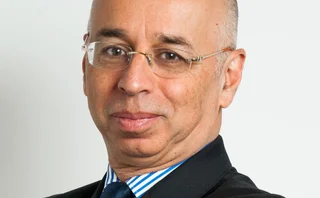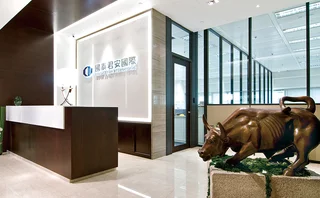
Market snapshot
Tim Mortimer analyses Future Value Consultants issuance data for the US and UK structured products markets and finds that non-US indexes are increasingly popular as underlyings in the US

The Euro Stoxx 50 index was a popular underlying for structured products launched in the US public market in September, accounting for around 15% ($150 million) of issuance and marking a revival of interest in Europe, as well as an increasing willingness on the part of US buyers to look overseas for investment opportunities. But by far the most popular underlying in the US is the S&P 500, which was the basis of $588 million of structured products. The most common single-stock underlying was Apple, while MetLife and Halliburton also proved popular.
Most products issued in the US in September had maturities of around 12 months. The average barrier for new 12-month reverse convertibles was 73%, the average coupon was 9.8%, and most products offered monthly income. The reverse convertibles with the highest coupon in September were trigger yield optimisation notes from UBS, which were linked to the common stock of Alpha Natural Resources and offered 21.65% per annum. The figure is attributable to the high volatility of the underlying asset, which currently stands at 75%, according to data used by FVC. Periods of high volatility increase the chances of a barrier breach significantly, and in order to balance the higher risk of the product, issuers try to attract investors by offering better terms.
The most popular product type in the US was the leveraged return note, which comprised over 57% of the market based on the notional amount. Part of the structure's appeal is the simplicity of its payout profile. Second most popular were autocallable bonds with a 9% share, followed by reverse convertibles with 8% of total issuance.
Bank of America led the US issuer table in September, with 30% of all products issued, based on the notional amount. It was followed by Royal Bank of Canada, which took 15% of the market, and Barclays with 13%.
In the UK, the most common underlying in September was, as usual, the FTSE 100, while the most prolific issuer of structured products was Investec Structured Products with a 27% market share. Royal Bank of Scotland was second, launching 19% of all products, and Morgan Stanley was third, accounting for 11% of total issuance.
Capital-at-risk annual kickout notes dominated the products brought to the UK market. Other popular structures were: principal-protected simple growth products and capital-at-risk growth products.
Only users who have a paid subscription or are part of a corporate subscription are able to print or copy content.
To access these options, along with all other subscription benefits, please contact info@risk.net or view our subscription options here: http://subscriptions.risk.net/subscribe
You are currently unable to print this content. Please contact info@risk.net to find out more.
You are currently unable to copy this content. Please contact info@risk.net to find out more.
Copyright Infopro Digital Limited. All rights reserved.
You may share this content using our article tools. Printing this content is for the sole use of the Authorised User (named subscriber), as outlined in our terms and conditions - https://www.infopro-insight.com/terms-conditions/insight-subscriptions/
If you would like to purchase additional rights please email info@risk.net
Copyright Infopro Digital Limited. All rights reserved.
You may share this content using our article tools. Copying this content is for the sole use of the Authorised User (named subscriber), as outlined in our terms and conditions - https://www.infopro-insight.com/terms-conditions/insight-subscriptions/
If you would like to purchase additional rights please email info@risk.net
More on Structured products
A guide to home equity investments: the untapped real estate asset class
This report covers the investment opportunity in untapped home equity and the growth of HEIs, and outlines why the current macroeconomic environment presents a unique inflection point for credit-oriented investors to invest in HEIs
Podcast: Claudio Albanese on how bad models survive
Darwin’s theory of natural selection could help quants detect flawed models and strategies
Range accruals under spotlight as Taiwan prepares for FRTB
Taiwanese banks review viability of products offering options on long-dated rates
Structured products gain favour among Chinese enterprises
The Chinese government’s flagship national strategy for the advancement of regional connectivity – the Belt and Road Initiative – continues to encourage the outward expansion of Chinese state-owned enterprises (SOEs). Here, Guotai Junan International…
Structured notes – Transforming risk into opportunities
Global markets have experienced a period of extreme volatility in response to acute concerns over the economic impact of the Covid‑19 pandemic. Numerix explores what this means for traders, issuers, risk managers and investors as the structured products…
Structured products – Transforming risk into opportunities
The structured product market is one of the most dynamic and complex of all, offering a multitude of benefits to investors. But increased regulation, intense competition and heightened volatility have become the new normal in financial markets, creating…
Increased adoption and innovation are driving the structured products market
To help better understand the challenges and opportunities a range of firms face when operating in this business, the current trends and future of structured products, and how the digital evolution is impacting the market, Numerix’s Ilja Faerman, senior…
Structured products – The ART of risk transfer
Exploring the risk thrown up by autocallables has created a new family of structured products, offering diversification to investors while allowing their manufacturers room to extend their portfolios, writes Manvir Nijhar, co-head of equities and equity…
Most read
- Breaking out of the cells: banks’ long goodbye to spreadsheets
- Too soon to say good riddance to banks’ public enemy number one
- Industry calls for major rethink of Basel III rules







